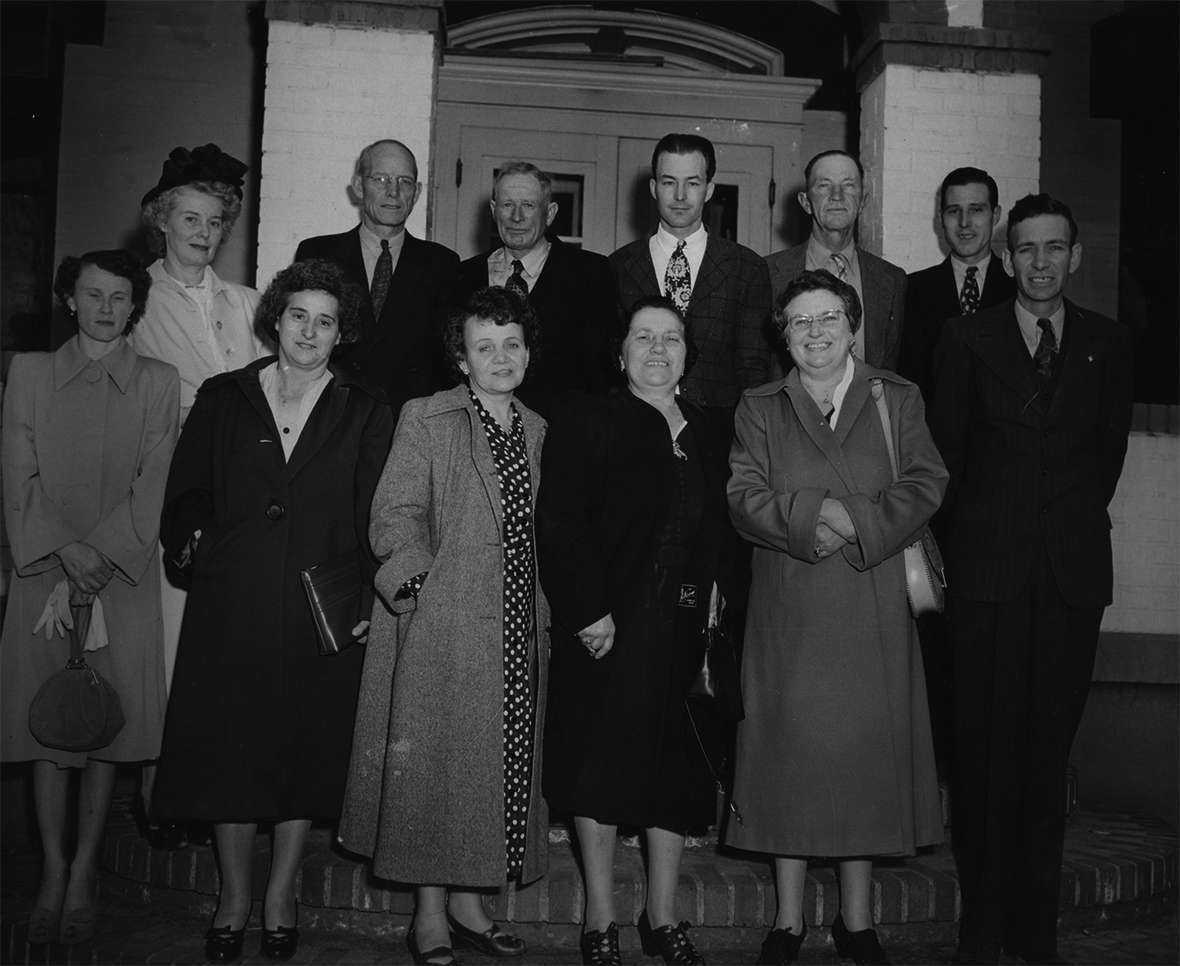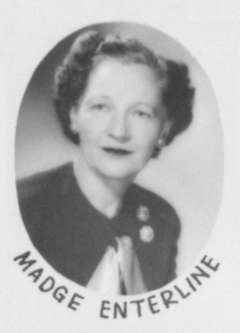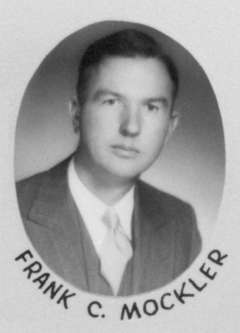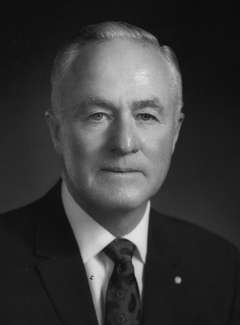- Home
- Encyclopedia
- “Those Damn Women:” Louise Graf and Women On Wy...
“Those Damn Women:” Louise Graf and Women on Wyoming Juries
On May 9, 1950, a court in Green River, Wyo. found Otto Long guilty of second-degree murder. Long's attorney, Walter Muir Sr., complained, "I'd never have lost if it hadn't been for those damn women on the jury."
Did some men expect more lenient verdicts from all-male juries? Apparently so. For the past 80 years, they had been enjoying this bias, whether perceived or real, but now the fun was over.
With one minor exception, an 1891 civil case in the Bighorn Basin town of Bonanza, Wyo., the Long jury was the first with women on it after 1890, when Wyoming became a state. Members of the 1950 jury, which included six women, chose Louise Spinner Graf as their foreman, making her almost certainly the first woman in Wyoming, after statehood, to hold that office.

Woman jurors in Wyoming Territory
Wyoming's territorial government had paved the way on Dec. 10, 1869, when Gov. John Campbell signed into law the bill granting women the right to vote and to hold public office. Jury duty followed soon after the woman suffrage law when early in1870 Territorial Chief Justice John Howe called women to serve. Howe’s call came over the objection of Albany County Attorney Stephen Downey, who most likely cited a law, also passed by the territorial legislature the previous December, that limited jury service to men.

Howe quashed Downey’s objection and on March 9, 1870, Eliza Stewart, an unmarried schoolmistress from Laramie, Wyo., became the first woman in the known history of the world to be subpoenaed for jury duty. Mrs. Martha Boies of Laramie was the first female bailiff, and Amalia Post of Cheyenne was the first woman jury foreman.
Recollections of Sarah Wallace Pease, another of the early woman jurors, were published in 1897.
Pease wrote that Howe and his associate justices wanted female jurors because "hitherto they had been unsuccessful in securing juries that would convict well-known guilty criminals." "The community [of Laramie] at that time was led and controlled by lawless and desperate men. … [T]here was a public sentiment that did not demand that criminals should be punished for their deeds. The Judge believed that women serving on the juries would remedy this flagrant evil, and inaugurate a better condition of things."
Reporters and artists from leading periodicals flocked to Laramie from all over the nation to view the novelty. "Of course, we were caricatured in the most hideous manner," wrote Pease. "Some of us were represented as sharp-nosed spinsters, holding a favorite cat or lap dog." The female jurors wore heavy veils when going to and from the court, and refused to sit in a body for their pictures.
The grand jury on which Pease served included six women. The panel met in Laramie for three weeks, considering several murder cases as well as horse and cattle theft. In its most unpopular decision, that jury enforced the law requiring saloons to close on Sunday. "The courts were persistent in enforcing the [saloon closure] law, and imposed fines and penalties without stint," wrote Pease. "Nothing that had been done before created as much ill feeling."
Women also served on petit juries for three terms of court, convicting murderers and thieves, until Howe retired in September 1871. His successors opposed female jurors. In 1891, the Sept. 17 Cheyenne Daily Leader and the Sept. 19 Laramie Weekly Sentinel carried the same short paragraph from the Big Horn Rustler in Bonanza, Wyo, reporting that two women served on a civil jury in the case of W. S. Collins vs. E. Minnie Whittington. After this, the issue of female jurors appears to have lain dormant in Wyoming until 1949.

 |
Meanwhile, other states were admitting women to jury service, with Utah leading in 1898. By 1949, 40 states, including Wyoming, allowed or required female jurors. By 1953, only six states were still holding out. A federal court decision in 1966, ruling that both racial and gender distinctions in state juries were unconstitutional, forced these six to capitulate. Mississippi was last, in 1968.
Wyoming's Woman Jury bill
On Feb. 19, 1949, Wyoming Gov. Arthur G. Crane signed House Bill No. 40, known as the "Woman Jury Bill." Introduced by Reps. Frank Mockler, Fremont County, and Madge Enterline, Natrona County, it was supported by many women's organizations throughout the state. Effective Jan. 1, 1950, the bill read, "A person is competent to act as juror if he or she be:" and the list of existing qualifications followed—U.S. citizen, state and county resident, owner of taxable property and fluent in English. The bill also stated that a juror must be "[i]n possession of his or her natural faculties."
Despite this clear language, in February 1950 a defense attorney questioned it in a case pending in Albany County, in which Francis K. Yazzie was charged with criminal assault. Yazzie's attorney claimed that female jurors were ineligible because the 1949 legislation was invalid until the state constitution was amended. This question moved quickly to the Wyoming Supreme Court, which ruled on May 5, 1950, that the statute was sufficient, with no need to change the constitution. Subsequently, State vs. Yazzie was dismissed due to the disappearance of witnesses, but the trial of Otto Long opened in Sweetwater County only three days later. Women began to serve on juries throughout other parts of Wyoming as well.
Louise Spinner Graf, jury foreman
"[The jury] said that we should have a woman foreman," Louise Spinner Graf reminisced 25 years after the conviction of Otto Long. "[T]hey thought that I should be—because having lived here so long, and my people having been here so long."
Graf's father, Karl Spinner Jr., married Therese Weber in Renchen, Germany on April 22, 1901. The couple traveled to Green River, arriving on June 1 of that year, and lived there for the rest of their lives. Their daughter Louise was born in Green River on March 2, 1904.
Louise Spinner was valedictorian of the Green River Lincoln High School's graduating class of 1923. Majoring in accounting at the University of Wyoming, she returned to Green River after graduating and worked at the First National Bank and later at the State Bank of Green River, where she was the first female assistant cashier in their history.
On June 14, 1930, she married George J. Graf, of Arvada, Colo. For most of his career he worked in Rock Springs, Wyo., for the company that become Pacific Power and Light. The couple had one daughter, Mary Louise.
Graf joined the Woman's Club in Green River in 1932, serving as treasurer and auditor. She became an associate member of the Girl Scouts of America in 1940, and was involved for more than 30 years. She and her husband also organized and worked for the Sweetwater County Fair, and helped to start the Sweetwater County Historical Society. Louise served on the first executive board in 1956. A longtime member of the Wyoming State Historical Society, Graf wrote papers about many of her community activities, including the details of her jury service.
Commenting on the evidence in the Long case, Graf observed, "[I]t seemed that there were two fellows coming from Rock Springs and they had been drinking, and they stopped halfway between here and Rock Springs and got out of the car. And one shot the other, and killed him. … [O]f course we found him guilty."
As with any other jury, the members were isolated from the public. "[T]hey let us call home," Graf recalled, "to get something to stay overnight." Graf's daughter packed her a "real nice little suitcase." And, Graf reported with some amusement, "[O]ne man was so mad when his wife called him. He was from Rock Springs. About packing her suitcase. He had told her to tell them that she did not believe in capital punishment. And she didn't do it. And she was chosen. … [H]e just pretty near threw … [the suitcase] at her. He was just that mad that she was on that jury."
Women as jurors
The results of the "woman jury experiment" were unsurprising: Good female jurors, like good male jurors, are conscientious and committed to justice. There are also bad jurors of both sexes. This was probably well known back in 1870 by the time the first female jurors served in Wyoming Territory. "The story had obtained credence," wrote Pease, "that former [all-male] juries were in the habit of flipping coppers, shaking dice or playing a game of cards to determine what their verdict should be." At the same time the first female jurors criticized one of their number for embarrassing them, according to Pease, by "sitting there and knitting all day long."

Pease commented that the criminals and their supporters found "many ready to reassure them that they had nothing to fear, for women were chicken-hearted, and their tender feelings could easily be wrought upon." One prisoner was "a handsome young man, of a pale, dreamy Byronic type." The jury "promptly voted a verdict of guilty," presumably on the evidence, and he was sentenced to 10 years in prison.
Beginning in 1950, court after court in Wyoming seated female jurors, with the first all-woman jury serving in Cody in January 1951. The comments of Wyoming judges and attorneys were uniformly positive. Justice Glenn Parker, who presided at the Long trial and later served on the Wyoming Supreme Court, stated, "I feel that the administration of justice in the State of Wyoming has been improved." Justice G.A. Layman of Sheridan reported that, "The fact that none of my [mixed male and female] juries were out an unreasonable length of time leads me to believe that women are just as willing as men to reconcile and compromise differences of opinion for the sake of reaching a just and fair verdict."
Louise Spinner Graf lived to be 93, dying on Oct. 28, 1997, in Laguna Beach, Calif. Her service as, apparently, the first female jury foreman since Wyoming territorial days remains an important milestone in the history of the state.
Resources
Primary Sources
- Barton, Bill. "Louise Graf, Jury Foreman and Green River Citizen." WyoHistory.org. Accessed Sept. 23, 2016, at www.wyohistory.org/oral-histories/louise-graf-jury-foreman-and-green-river-citizen.
- "District Court Session Will Open Here Monday Morning." Unidentified newspaper clipping, May 4, 1950. Jury-Women research file, Sweetwater County Historical Museum, Green River, Wyo. (Hereafter SCHM)
- Graf, Louise Spinner. "The Spinner's [sic] in Green River." Sept. 2, 1949. Spinner/Gaensslen/Graf family file, SCHM.
- _______________. "Women on the Jury, 1950." Paper prepared and read by Louise Spinner Graf at the Sweetwater County Historical Society meeting, Feb. 8, 1970. Spinner/Gaensslen/Graf family file, SCHM. Also in Wyoming Blue Book, Vol. III, edited by Virginia Cole Trenholm. Cheyenne, Wyo.: Wyoming State Archives and Historical Department, 1974, 422-425. Accessed Sept. 21, 2016, at http://wyoarchives.state.wy.us/pdf/WyomingBlueBookThree.pdf.
- "Graf's historical moment draws world interest." Unidentified newspaper clipping, no date. Spinner/Gaensslen/Graf family file, SCHM.
- "Jury Session to Open Here Monday; Supreme Court Okays Women Jurors." Unidentified newspaper clipping, no date. Jury-Women research file, SCHM.
- "Louise Graf Dies Oct. 28." Rock Springs Rocket, Oct. 29, 1997. Spinner/Gaensslen/Graf family file, SCHM.
- "Otto Long Murder Trial Starts Session of Court." Rock Springs Daily Rocket, May 9, 1950. Jury-Women research file, SCHM.
- Parker, Glenn. "The Significance of the Yazzie Case." Wyoming Blue Book, Vol. III, edited by Virginia Cole Trenholm. Cheyenne, Wyo.: Wyoming State Archives and Historical Department, 1974, 420-422. Accessed Sept. 21, 2016, at http://wyoarchives.state.wy.us/pdf/WyomingBlueBookThree.pdf.
- Pease, Sarah Wallace. "Women as Jurors." Wyoming Historical Collections, Vol. 1, 1897. Reprinted in Wyoming Business and Professional Women's Clubs. History of Jury Service for Women. Thermopolis, Wyo, 1953.
- Session Laws, 1949, Chapter 61, Original House Bill No. 40, Jurors. Wyoming Blue Book, Vol. III, edited by Virginia Cole Trenholm. Cheyenne, Wyo.: Wyoming State Archives and Historical Department, 1974, 419-420. Accessed Sept. 21, 2016, at http://wyoarchives.state.wy.us/pdf/WyomingBlueBookThree.pdf.
- "Women Serving on Jury Here For First Time." Unidentified newspaper clipping, May 1950. Jury-Women research file, SCHM.
- Wyoming Business and Professional Women's Clubs. History of Jury Service for Women. Thermopolis, Wyo, 1953. Jury-Women research file, SCHM.
- Wyoming Newspapers. Accessed Sept. 27, 2016, at http://newspapers.wyo.gov/:
- Cheyenne Daily Leader, Sept. 17, 1891; Laramie Weekly Sentinel, Sept. 19, 1891.
Secondary Sources
- "Glenn Parker: Wyoming Supreme Court 1955-1973." Accessed Sept. 19, 2016, at https://wyomingstatearchives.wikispaces.com/Glenn+Parker.
- Harrison, Cynthia. "Shoehorning American Women onto American Juries." H-Net Reviews in the Humanities & Social Sciences. Nov. 2013. Accessed Sept. 27, 2016, at http://www.h-net.org/reviews/showrev.php?id=38851.
- Hein, Rebecca. "Big Horn County, Wyoming." WyoHistory.org, accessed Sept. 27, 2016, at www.wyohistory.org/encyclopedia/big-horn-county-wyoming.
- "History+." Business and Professional Women's Foundation. Accessed Sept. 27, 2016, at http://bpwfoundation.org/about/history-2/.
- Larson, T. A. History of Wyoming. 2d. ed., rev. Lincoln, Neb.: University of Nebraska Press, 1978, 84-85.
- Rea, Tom. "Right Choice, Wrong Reasons: Wyoming Women Win the Right to Vote." WyoHistory.org, accessed Sept. 21, 2016, at www.wyohistory.org/essays/right-choice-wrong-reasons-wyoming-women-win-right-vote.
- ________. "John Campbell and the Invention of Wyoming." WyoHistory.org, accessed Sept. 21, 2016, at www.wyohistory.org/essays/john-campbell-and-invention-wyoming.
- Thompson, D. Claudia. "Amalia Post, Defender of Women's Rights." WyoHistory.org, accessed Sept. 21, 2016, at www.wyohistory.org/essays/amalia-post-defender-women's-rights.
- “Timeline 1949.” Wyoming Blue Book, Vol. III, edited by Virginia Cole Trenholm. Cheyenne, Wyo.: Wyoming State Archives and Historical Department, 1974, 457-458. Accessed Sept. 21, 2016, at http://wyoarchives.state.wy.us/pdf/WyomingBlueBookThree.pdf.
- Whittenberg, Clarice. "Portrait of an 'Ordinary' Woman: Eliza Stewart Boyd." Annals of Wyoming 29: 1, April 1957. Accessed Sept. 20, 2016, at https://archive.org/stream/annalsofwyom29121957wyom#page/n33/mode/2up/search/jury.
Illustrations
- The 1950 photo of the jury is from the Sweetwater County Historical Museum. Used with permission and thanks.
- The photos of Frank Mockler and Madge Enterline are from the Wyoming State Archives. Used with permission and thanks.
- The photo of Sarah Pease is from the American Heritage Center at the University of Wyoming. Used with permission and thanks.
